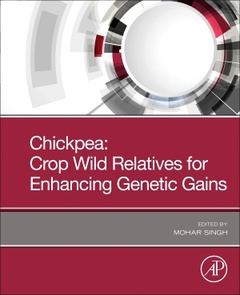Description
Chickpea: Crop Wild Relatives for Enhancing Genetic Gains
Coordinator: Singh Mohar
Language: English
Subjects for Chickpea: Crop Wild Relatives for Enhancing Genetic Gains:
274 p. · 19x23.3 cm · Paperback
Description
/li>Contents
/li>Readership
/li>Biography
/li>Comment
/li>
Chickpea: Crop Wild Relatives for Enhancing Genetic Gains explores aspects related to critical analysis on factors responsible for narrow genetic base of chickpea productions including domestication bottleneck, the level of diversity present in different cultivated and wild species, the uniqueness and usefulness of potential gene sources available and maintained in production systems across the globe, the level of genetic erosion both at landrace and species level over time and space etc. Despite considerable international investment in conventional breeding, production of chickpea has not yet been significantly improved beyond that achieved through its normal single domestication event and high self-pollination rate. Total annual pulse production of ~12 million tons (FAO 2016) is far below actual potential. Susceptibility to both biotic and abiotic stresses have created a production level bottleneck whose solution possibly lies in the use of crop wild relatives and other genetic traits cultivated by tailoring novel germplasm.
Presenting options for widening the genetic base of chickpea cultivars by introgression of diverse genes available in distantly related wild Cicer taxa, thus expanding the genetic base and maximize genetic gains from the selection, it is necessary to accumulate other complimentary alleles from CWRs. This review will focus on present status of gene pool and species distribution, germplasm conservation, characterization and evaluation, problems associated with crop production, sources of target traits available in wild species, status of trait introgression in synthesizing new gene pool of chickpea along with progress made in chickpea genomics.
An edited book with contributions from leading scientists, this information will guide and inform chickpea breeders, PGR researchers and crop biologists across the world.
1. Introduction 2. Origin, Distribution, and Gene Pools 3. Genetic Resources: Genetic resources: Collection, conservation (in-situ and ex-situ), characterization and maintenance 4. Conventional Cytogenetic Manipulations 5. Embryo Rescue and Chromosomal Manipulations 6. Gene Pyramiding and Multiple Character Breeding 7. Molecular Marker-Assisted Gene Pyramiding 8. Genetic transformation 9. Chickpea Economy in India
Chickpea breeders, PGR researchers and crop biologists
- Presents both conventional and emerging techniques
- Provides insights into gene pyramiding as cytogenic manipulations
- Includes case studies highlighting the impact of improving chickpea production




